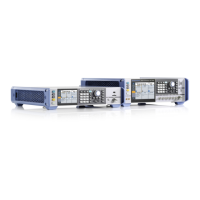File and Data Management
R&S
®
SMA100B
284User Manual 1178.3834.02 ─ 05
File handling
To access files and the file system of the instrument or to use the general file manage-
ment functions such as copying and moving data, use the standard "File Manager" dia-
log.
See Chapter 10.8, "Using the File Manager", on page 298.
To transfer files from and to the instruments or to exchange files, use one of the follow-
ing alternatives:
●
Connect a memory stick to one of the USB interfaces.
The instrument recognizes automatically a connected memory stick and assigns
the /usb/ drive to it.
●
Connect the instrument to a LAN.
An instrument connected to a LAN supports two standard file transfer methods
from a remote client:
– FTP (file transfer protocol)
– File sharing according to the SAMBA/SMB (server message block) protocol.
Both file transfer methods access the folder /user, that is the /var/user/ folder
on the instrument.
For step-by-step description, see Chapter 10.9, "How to Transfer Files from and to
the Instrument", on page 305.
●
Map a network folder or a computer to an instrument connected to a LAN.
A mapped network folder is indicated as /shares/<"Local Folder">.
For step-by-step description, see Chapter 10.8.4, "How to Map a Network Folder",
on page 302.
File naming conventions
To enable files to be used in different file systems, consider the following file naming
conventions:
●
The filename can be of any length and is case-sensitive, i.e it is distinguished
between uppercase and lowercase letters.
●
All letters and numbers are permitted (numbers are, however, not permitted at the
beginning of the filename).
●
Avoid using special characters.
●
Do not use slashes "\" and "/". These symbols are used in file paths.
●
Avoid using the following filenames: CLOCK$, CON, COM1 to COM4,
LPT1 to LPT3, NUL or PRN
They are reserved by the operating system.
File extensions
The R&S SMA100B distinguishes the files according to their extensions; each type of
file is assigned a specific file content and also a specific file extension. The extension
is usually of no consequence to you since access to the files occurs in the individual
dialogs where only the relevant type of file is available. For example, files with user
correction data can only be saved and loaded in the "UCOR" dialog.
About the File System

